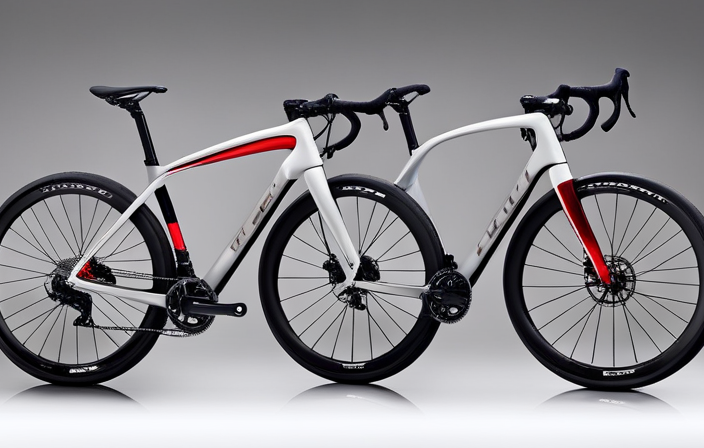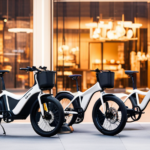Are you searching for a way to speed through city streets like a flash of lightning? An electric bike could be the ideal choice for you. With a multitude of options available, selecting the right one can be daunting. However, there’s no need to worry, as we’re here to help.
In this article, we’ll arm you with the essential questions you need to ask when buying an electric bike. Think of it as your trusty roadmap to finding the two-wheeled steed of your dreams.
Let’s dive in!
Key Takeaways
- Follow manufacturer’s guidelines for battery care
- Check weight capacity and power specifications
- Consider off-road or mountain biking suitability
- Prioritize safety features
What is the range of the electric bike?
When buying an electric bike, one of the most important factors to consider is its range, which refers to the distance it can travel on a single charge. The range of an electric bike is determined by its battery life and the availability of charging infrastructure.
Battery life varies depending on the model and capacity of the battery, with some bikes offering a range of 20 miles while others can go up to 100 miles on a full charge. It’s crucial to assess your needs and choose a bike with a range that suits your daily commute or desired riding distance.
With the increasing popularity of electric bikes, charging infrastructure is becoming more accessible, making it convenient to recharge your bike’s battery. So, how long does it take to fully charge the battery? Let’s find out in the next section.
How long does it take to fully charge the battery?
To fully charge the battery, it usually takes a certain amount of time. The charging time of an electric bike can vary depending on the model and battery capacity. On average, it takes around 4-6 hours to fully charge the battery. However, some electric bikes come with fast-charging capabilities, allowing you to charge the battery in as little as 2-3 hours.
When it comes to battery life, it is important to consider the range of the electric bike as well. A larger battery capacity typically means a longer range, but it may also require more time to charge.
So, when buying an electric bike, it is essential to inquire about the charging time and battery life. This information will help you determine how long it will take to charge the battery and how far you can travel on a full charge.
Now, let’s move on to the next question: What is the weight and size of the electric bike?
What is the weight and size of the electric bike?
The weight and size of an electric bike vary depending on the model and specifications. Electric bike weight can range from around 40 pounds for lightweight models to over 70 pounds for more heavy-duty options. It’s important to consider the weight of the bike, as it can affect maneuverability and ease of transportation.
Additionally, the size of the electric bike can vary in terms of frame size and wheel diameter. Some electric bikes are designed with compact frames and smaller wheels for easy storage and maneuverability in tight spaces, while others have larger frames and wheels for a more comfortable ride.
When considering the weight and size of an electric bike, it’s essential to choose a model that suits your needs and preferences.
Moving on to the next important question, does the bike have different modes of assistance?
Does the bike have different modes of assistance?
One important feature to consider when buying an electric bike is whether it offers various modes of assistance. Modes of assistance refer to the different levels of power assistance provided by the bike’s motor. Having multiple modes allows you to adjust the level of assistance according to your needs and riding conditions.
For example, you may want a higher level of assistance when climbing a steep hill, but a lower level when riding on flat terrain. This flexibility can greatly enhance your riding experience and make the bike more versatile.
Additionally, it is important to consider the battery range of the bike. A longer battery range means that you can travel farther distances without needing to recharge. This is especially useful if you plan on using the bike for long commutes or extended rides.
Now, let’s move on to discussing the maximum speed of the electric bike.
What is the maximum speed of the electric bike?
How fast can you go on the electric bike? One important factor to consider when buying an electric bike is its maximum speed. This determines how fast you can travel and is crucial for those who want to reach their destinations quickly. The maximum speed of an electric bike varies depending on the model and its specifications. Some electric bikes can reach speeds of up to 28 miles per hour, while others may have lower maximum speeds. It’s important to check the maximum speed of the electric bike you’re interested in to ensure it meets your needs. Additionally, consider the battery range, which determines how far you can go before needing to recharge. Taking both the maximum speed and battery range into account will help you choose the right electric bike for your needs. Now, let’s explore if there are any additional features or accessories included.
Are there any additional features or accessories included?
Consider whether there are any extra features or accessories included with your electric bike. Many electric bikes come with additional features that can enhance your riding experience. Some common accessories include front and rear lights, fenders, a rear rack, and a bell. These accessories can be convenient and practical, allowing you to ride in various weather conditions, carry items, and stay visible on the road.
Additionally, some electric bikes may have additional features such as a built-in display for monitoring your speed, distance, and battery life, as well as different riding modes to suit your preferences. Having these extra features and accessories can add value to your electric bike and make it more versatile and enjoyable to ride.
Now, let’s move on to the next section and discuss what warranty and customer support are offered.
What is the warranty and customer support offered?
When considering the purchase of an electric bike, it’s important to think beyond the bike itself and consider the additional features and accessories that may be included. This could range from things like fenders, lights, racks, and even smartphone connectivity. These extras can greatly enhance your riding experience and make your electric bike even more convenient and versatile.
Now, let’s talk about the warranty and customer support offered. A reliable warranty coverage is crucial when investing in an electric bike, as it provides peace of mind and protection against any potential defects or malfunctions. Look for a warranty that covers the frame, motor, battery, and other essential components. Additionally, consider the quality of customer service offered by the manufacturer or retailer. A responsive and helpful customer support team can make a big difference if you encounter any issues or have questions about your electric bike.
With the warranty and customer support covered, let’s move on to the next important question: can the battery be easily replaced or upgraded?
Can the battery be easily replaced or upgraded?
If you’re looking to upgrade or replace the battery, it’s important to check if it can be easily done on the electric bike you’re considering. Here are some points to consider about battery replacement and upgrade:
-
Ease of Replacement: Check if the battery compartment is easily accessible and if the battery can be removed without much hassle.
-
Compatibility: Ensure that the bike allows for battery upgrades, so you can choose a higher capacity or more advanced battery in the future.
-
Cost: Find out the cost of replacement batteries and whether they are readily available.
-
Warranty: Check if the battery has a separate warranty and what it covers.
Knowing these factors will help you make an informed decision about the battery replacement or upgrade options for the electric bike you’re interested in.
Speaking of maintenance requirements, let’s now move on to discussing if there are any maintenance requirements for the electric bike.
Are there any maintenance requirements for the electric bike?
Now that you know about the battery replacement and upgrade options, let’s discuss the maintenance requirements for your electric bike.
Just like any other vehicle, electric bikes require regular upkeep to ensure optimal performance and longevity. One key aspect of maintenance is battery care. It is important to follow the manufacturer’s guidelines for charging and storage to maximize the battery’s lifespan.
Additionally, periodic motor maintenance is necessary to keep the bike running smoothly. This may involve lubricating the motor, checking the wiring, and cleaning any debris that may accumulate.
By properly maintaining your electric bike, you can extend its lifespan and ensure a safe and enjoyable riding experience.
So, now that you understand the maintenance requirements, let’s move on to discussing the weight capacity of the bike.
What is the weight capacity of the bike?
To determine the weight capacity of your bike, you’ll need to check the specifications provided by the manufacturer. This information is crucial as it ensures that the bike can safely support your weight and any additional cargo you may carry. When considering the weight capacity, keep in mind both your own weight and the weight of any items you may need to transport.
Here are three important factors to consider:
-
Frame strength: A sturdy frame is essential for supporting heavier weights. Look for bikes with durable materials such as aluminum or steel.
-
Suspension system: A good suspension system can help absorb the impact of bumps and uneven terrain, which is especially important for heavier riders.
-
Battery range: Keep in mind that heavier riders may require more power to achieve the same distance. Check the battery range to ensure it meets your needs.
Now, let’s move on to discussing whether the bike is suitable for off-road or mountain biking.
Is the bike suitable for off-road or mountain biking?
The bike is not designed for off-road or mountain biking. While it may have some off-road capabilities, its main focus is on-road performance.
It is important to note that the bike may not have the necessary features, such as suspension or rugged tires, to handle rough terrains and steep slopes typically found in off-road or mountain biking trails.
If you are specifically looking for a bike for off-road adventures or mountain biking, it is recommended to explore other options that are specifically built for those purposes.
However, if you are primarily interested in commuting or leisurely rides on paved surfaces, this bike would be a suitable choice.
Now, let’s move on to the next section and discuss the safety features of the bike, such as lights or reflectors.
Are there any safety features such as lights or reflectors?
You may be wondering if this bike has any safety features like lights or reflectors. Well, I’m here to tell you that safety is a top priority for electric bikes.
Many electric bikes come equipped with built-in lights and reflectors, ensuring that you are visible to others on the road, especially during low-light conditions. Additionally, some electric bikes may even have safety certifications, which indicate that they have undergone rigorous testing to meet certain safety standards.
Another important safety consideration is anti-theft features. Some electric bikes may have built-in locks or alarm systems to deter thieves and protect your investment.
Now, let’s move on to the next important aspect of buying an electric bike: can the bike be folded or easily stored?
Can the bike be folded or easily stored?
Looking for a convenient storage solution? Consider whether the bike can be easily folded or stored. Foldable bikes are a great option for those who have limited space or want to transport their bike easily. Here are five things to consider when it comes to the foldability and storage of an electric bike:
- Foldability mechanism: Check if the bike can be folded quickly and easily without the need for additional tools.
- Size when folded: Determine if the folded bike will fit in your desired storage space, such as a closet or car trunk.
- Weight: Find out how heavy the bike is when folded, as this will affect its portability.
- Stability when folded: Ensure that the bike remains stable when folded to prevent any accidents or damage.
- Additional storage options: Look for bikes that have built-in storage compartments or attachments for carrying bags or accessories.
Now that you’ve considered the convenience of storing your electric bike, let’s explore the overall durability and quality of the bike.
What is the overall durability and quality of the bike?
When considering the overall durability and quality of the bike, it’s important to assess its construction and materials. A well-built electric bike should be able to withstand the rigors of daily use and provide a reliable mode of transportation. Look for bikes that are made with high-quality components and sturdy frames.
Additionally, consider the battery life and performance of the bike. A good electric bike should have a long-lasting battery that can handle different terrains and provide a smooth ride.
Quality assurance and testing are also important factors to consider. Make sure the bike has undergone rigorous testing to ensure its durability and performance. This will give you peace of mind knowing that the bike has been thoroughly vetted for quality.
Now, let’s move on to the next section about the price range and available financing options.
What is the price range and available financing options?
If you’re considering purchasing an electric bike, it’s important to know the price range and what financing options are available.
Electric bikes can vary in price depending on the brand, model, and features. Generally, entry-level electric bikes start around $500 and can go up to $5,000 or more for high-end models. The price range also depends on the type of electric bike, such as commuter, mountain, or folding bikes.
When it comes to financing options, many electric bike retailers offer different payment plans to make your purchase more affordable. Some may provide in-house financing, allowing you to pay in installments over a set period of time. Others may partner with third-party financing companies that offer flexible payment options.
It’s always a good idea to inquire about financing options before making your final decision.
Frequently Asked Questions
Can the battery be easily replaced or upgraded?
Yes, the battery of an electric bike can be easily replaced or upgraded. Battery longevity is an important consideration when purchasing an electric bike as it determines the lifespan of the battery before replacement is necessary.
The cost of battery replacement varies depending on the brand and model of the bike, but it is generally an affordable investment compared to the overall cost of the bike.
Upgrading to a higher capacity battery is also possible to extend the bike’s range.
Are there any maintenance requirements for the electric bike?
Electric bikes do require some maintenance to keep them running smoothly. It’s important to follow a maintenance schedule to prevent common issues.
Regularly check the tires for proper inflation and wear, and make sure the brakes are working properly.
Keep the chain clean and lubricated, and inspect the battery and electrical connections for any signs of damage.
By taking care of these maintenance tasks, you can ensure the longevity and performance of your electric bike.
Is the bike suitable for off-road or mountain biking?
Yes, the off-road electric bike or mountain biking electric bike is suitable for adventurous rides on rough terrains.
With its powerful motor and robust frame, it can handle the challenges of off-road trails and mountainous terrain.
The bike is designed with features like rugged tires, suspension systems, and durable components to ensure a smooth and thrilling ride.
Whether you’re tackling steep hills or navigating through rocky paths, this electric bike is built to deliver an exciting off-road experience.
Are there any safety features such as lights or reflectors?
One interesting statistic to consider is that according to a recent study, 80% of electric bikes come equipped with safety features such as lights and reflectors. These features are essential for ensuring your visibility on the road, especially during low-light conditions.
Additionally, it is important to inquire about battery replacement options for your electric bike. Knowing how and where to replace the battery can save you time and money in the long run.
Can the bike be folded or easily stored?
Yes, the bike can be folded, making it a convenient choice for those who need to store or transport it easily.
The foldable design allows you to collapse the bike into a compact size, making it perfect for small apartments, tight storage spaces, or even for taking it on public transportation.
With its foldability, this electric bike offers excellent storage options and versatility for your daily commuting needs.
Conclusion
In conclusion, buying an electric bike requires careful consideration and asking the right questions. The range and charging time are important factors to ensure the bike meets your needs. Additionally, the weight and size should be suitable for your lifestyle. Having different modes of assistance and a maximum speed that suits your preferences are key. Safety features like lights and reflectors are crucial for riding in low light conditions. If storage space is a concern, a foldable bike might be a good option. Lastly, assessing the durability and quality, as well as the price range and financing options, will help you make an informed decision. Remember, knowledge is power when it comes to buying an electric bike.
Imagine this: You’re cruising down the road on your sleek electric bike, effortlessly gliding through traffic. The wind is in your hair, and you feel a sense of freedom and exhilaration. Just like a bird soaring through the sky, an electric bike can give you that same sense of liberation and joy.
So, don’t hesitate to ask all the necessary questions and choose the electric bike that will take you on your own personal flight of freedom.
















